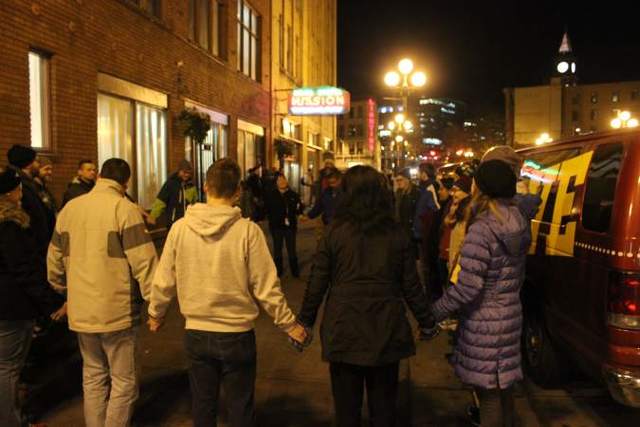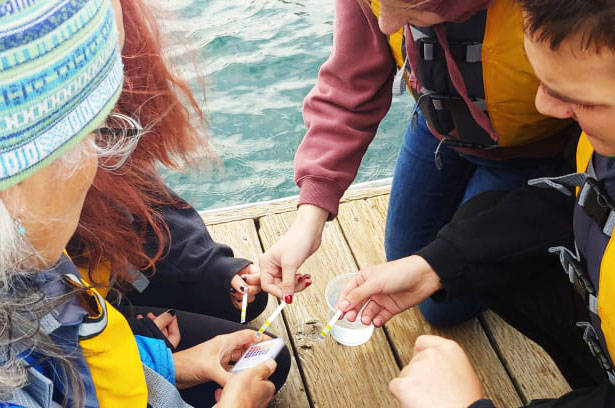For 20 years, homeless people and the public have gathered weekly at the ROOTS Young Adult Shelter in the U District for a community dinner called Friday Feast.
When Kristine Cunningham started working at the shelter eight years ago, she recalls, it was easy to distinguish volunteers from the homeless. Volunteers would stick to their roles, for example limiting their involvement to serving food while the homeless ate. They also didn’t strike her as typical Seattleites; rather, they were social-justice-minded, radical people.
But that’s changed recently. Volunteers have become more interested in getting to know the people on the other side of the serving tray, and have come to represent a wider swath of the city.
“Now I’m seeing people that I would consider more everyday, run-of-the-mill people who are, like, sitting down and having dinner with them, or not even showing up as volunteers, just showing up as guests to hang out with people who are homeless,” Cunningham says. “I think people’s awareness of the problem and the more humanitarian perspective on the issue has increased.”
ROOTS hasn’t made any effort to recruit volunteers for Friday Feast. The volunteers aren’t trained or scheduled. The change happened organically.
ROOTS was one of a score of homeless organizations Seattle Weekly reached out to in recent weeks with a simple question: With homelessness spiking in Seattle—and dominating the news cycle—are residents here responding by donating more money and time to services to help the dispossessed?
The informal survey did not provide a cut-and-dried answer. Some service providers didn’t have the data; others suggested it was their outreach campaigns, and not the 5 o’clock news, that was driving up donations and volunteerism. Yet on the whole, it appears that ROOTS is no anomaly.
Compassion, it seems, is in fashion.
Mary’s Place, a North Seattle shelter that caters to mothers with children, has seen a 25 percent increase in cash donations and a 26 percent increase in volunteer hours from 2014 to 2015. Marketing and communications director Linda Mitchell says the increases might be due to the organization’s growth as a whole, including the addition of more shelters and increasing events and press activities.
Volunteer hours increased 16 percent from 2014 to 2015 for Operation Sack Lunch, a provider that supplies thousands of pounds of food every year to shelters, tent cities, and other service providers in King County.
The One Night Count, led by the Seattle/King County Coalition on Homelessness, has a wait list for people who want to volunteer, despite having doubled their number of volunteers in the past eight years based on public demand for the Count, says executive director Alison Eisinger.
Eisinger has also noticed a spike in public interest in her group’s homelessness-advocacy workshops. The workshops teach citizens to advocate for policy related to homelessness and affordable housing at city, county, and state levels. Attendance between the first and second workshops in 2015 and 2016 increased 25 percent.
“People in both Seattle and King County, I would say, are hungry for real opportunities to make a difference around homelessness,” Eisinger says. The workshops draw a wide range of people, including professors, students, volunteers, and homeless people. “They know that in addition to providing a meal or helping with shelter or providing mental-health care, that they also need to have a voice on what our government does in response.”
At Seattle’s Union Gospel Mission, volunteer hours for the months September through January increased an incredible 70 percent between 2014 and 2015. Public relations manager Torie Rynning says it’s difficult to attribute that increase directly to people becoming more compassionate toward homelessness, but their team wouldn’t be surprised if that were the case, as they’ve noticed more volunteers having open conversations about the crisis.
Another possible factor in the increased philanthropy is the good fortune being enjoyed in other quarters of Seattle. Indeed, not everyone is finding money hard to come by; King County’s median household income rose 35 percent between 2000 and 2013, to $71,834.
But again, clear answers are hard to determine.
Effective Altruism, a movement that applies evidence and reason to determine the most effective ways to improve the world through donation, is one group that hasn’t changed the way it operates due to the rise of homelessness. Many members of Seattle Effective Altruism, the local chapter, are millennial tech workers.
Because homelessness is a systematic problem, it’s difficult to measure the impact that donating to homeless services can really have, says SEA organizer Sydney Martin. If it’s proven that your dollars will help deworm a child in a Third World country, effective altruists will donate their dollars there, rather than buying a homeless person a blanket, for example. Not to say that effective altruists aren’t compassionate—they certainly are. Martin says she volunteers at a homeless shelter because it makes more difference than donating financially.
For Cunningham at ROOTS, the big takeaway from all this is that in a city with hugely disparate wealth, people are trying to understand how the other half lives.
“The homelessness crisis, if it increases housed people’s awareness of how housing-fragile they are, then they become compassionate, then they can relate,” she says. “We live in a society that tries to make the homeless ‘those people over there.’ Frankly it’s not until we do something like volunteer that that myth gets busted.”
Seattle Weekly delivers the latest in city politics, crime, and business news. If you know something we should know, e-mail news@seattleweekly.com. Follow us on Facebook, Twitter, and Instagram or subscribe to our weekly newsletter for more Seattle news.








